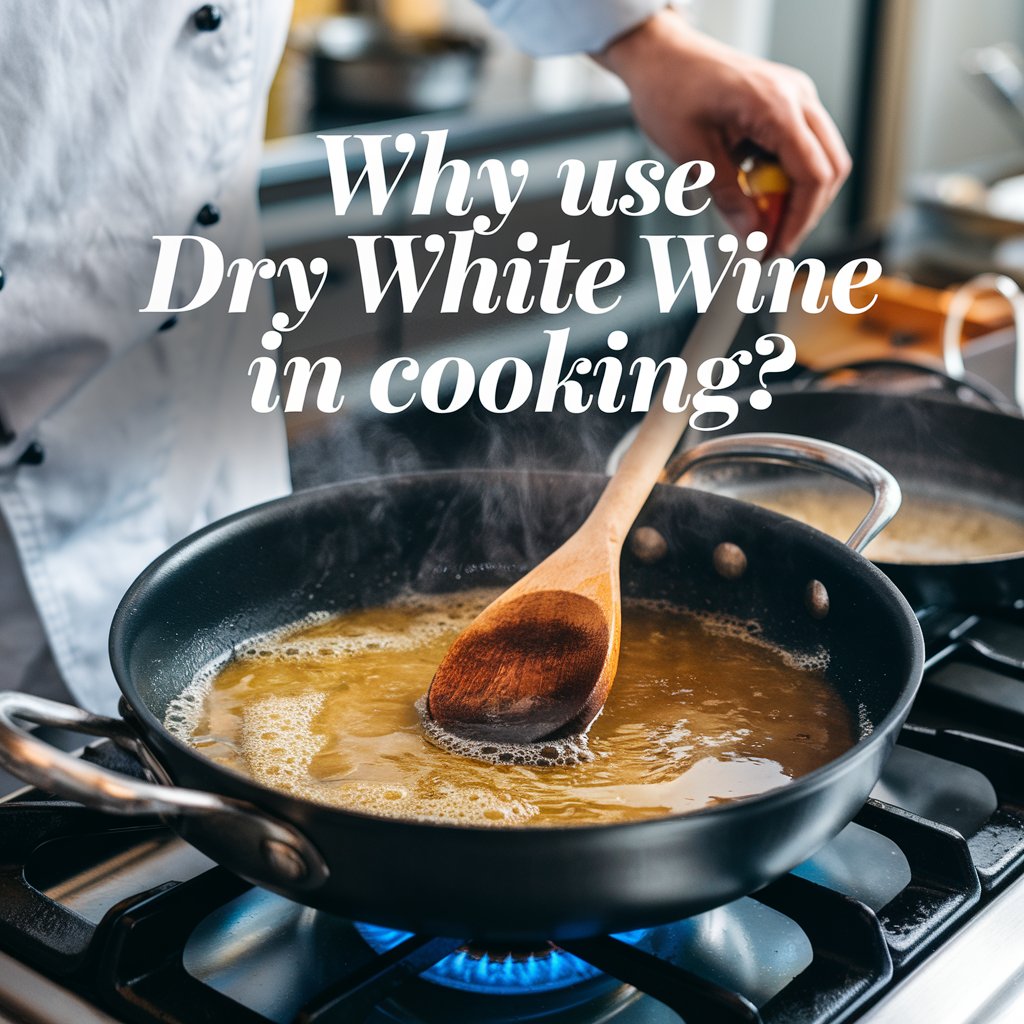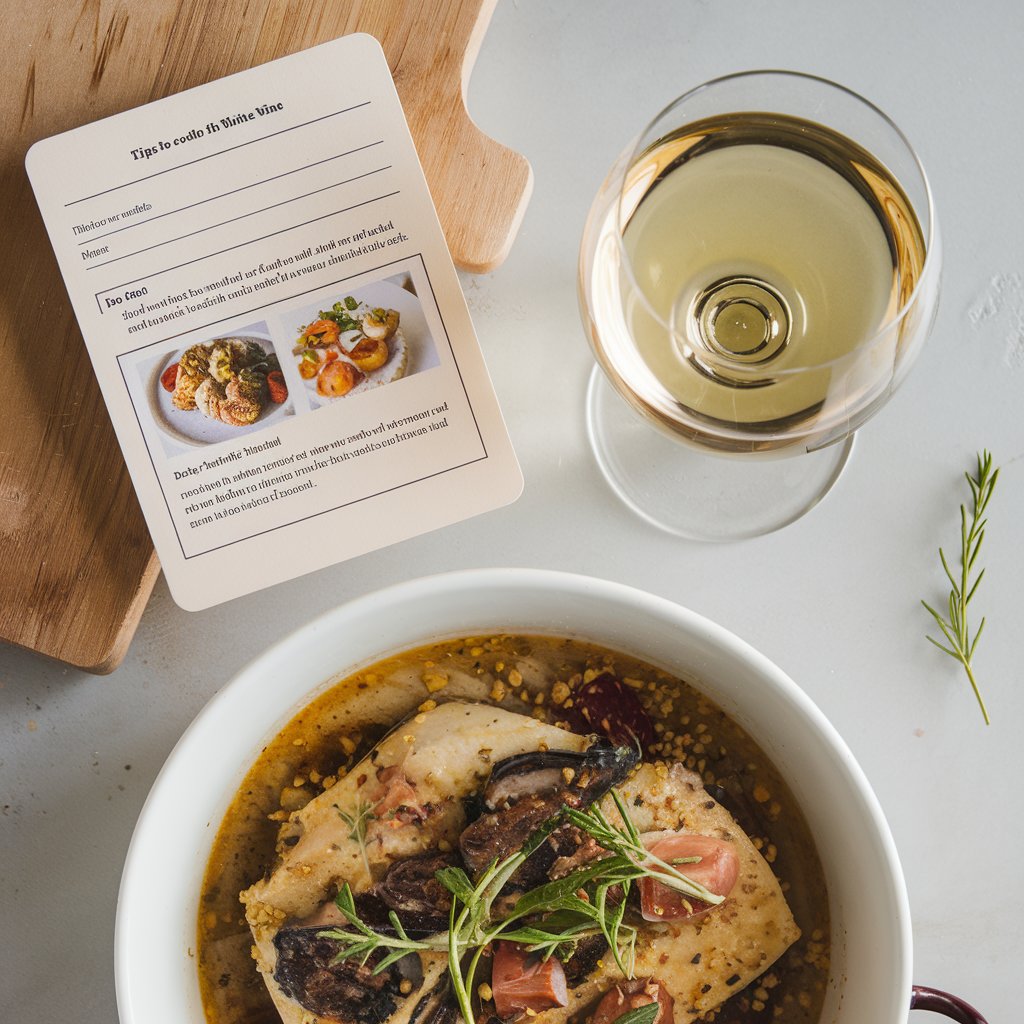Introduction
Dry white wine for cooking is a long-standing custom that has been used in many different cuisines all over the world. Dry white wines are one of the most popular varieties of wine used in cooking because of their adaptability and capacity to bring out the flavors of a variety of foods.
This extensive tutorial will examine the kinds of dry white wines that work best in the kitchen, how to match one to your dish, and how to cook with white wine to get the most out of it.
Why Use Dry White Wine in Cooking?

White wine can help balance flavors and produce a more complete taste by adding depth, complexity, and a hint of acidity to food. Additionally, it can aid in deglazing pans, which facilitates the addition of browned pieces to sauces for umami and richness. The following are some main justifications for why dry white wine is a useful culinary ingredient:
Flavor Enhancement:
White wine’s acidity and aromatic components can enhance a dish’s flavor, giving it additional depth and vibrancy.
Deglazing:
To help remove the fond—the caramelized pieces that stick to the pan—and incorporate it into a sauce, white wine can be used to deglaze the pan after sautéing meat or vegetables.
Moisture Addition:
White wine for cooking can give meals like braises, stews, and risottos a bit of moisture without letting them become unduly rich or heavy.
Marinades:
White wine’s acidity makes it a great foundation for marinades, giving meat more taste and tenderness.
Versatility:
Seafood, poultry, veggies, and desserts are just a few of the foods that dry white wine can be utilized in.
Types of Dry White Wines for Cooking
Cooking with dry white wines can be done differently with each one. The final flavor of your food can be greatly influenced by the wine you choose. Here are a few of the dry white wines that are most frequently used in cooking:
Sauvignon Blanc:
Distinguished by its strong acidity and herbaceous undertones, Sauvignon Blanc pairs well with light, fresh foods like shellfish, poultry, and vegetable preparations. It is very useful in recipes calling for a spicy, vibrant flavor.
Chardonnay:
Chardonnay pairs well with creamy and buttery meals because of its full-bodied, rich flavor. It’s ideal for dishes like risottos, creamy soups, and sauces.
Pinot Grigio:
This crisp, light wine goes well with shellfish and chicken meals. Because of its delicate flavor, it melds perfectly with the other ingredients without taking center stage.
Dry Vermouth:
Despite not being a typical wine, its unique flavor and strong acidity make it a popular ingredient in cooking. For soups, sauces, and deglazing pans, it’s perfect.
Muscadet:
Originating in France’s Loire Valley, Muscadet is renowned for its citrus and mineral overtones. It goes incredibly well with seafood meals and shellfish.
Riesling:
Riesling can be sweet, but it can also be dry and great in the kitchen. Its strong acidity and delicate floral aromas make it a flexible match for many different foods, like as pork and Asian-inspired cooking.
Albariño:
This delicious Spanish wine is renowned for its clean acidity. It’s a great option for seafood recipes, especially ones with a Mediterranean influence.
Choosing the Right Dry White Wine for Your Recipe
When choosing a dry white wine for cooking, it’s important to take into account the unique qualities of the wine and how they will work with the food. The following advice will help you select the ideal wine for your recipe:
Match the Intensity:
Fuller-bodied wines go well with richer foods, and lighter wines go well with delicate dishes. For instance, pair Chardonnay with a rich chicken casserole and Sauvignon Blanc with a light fish dish.
Consider Acidity:
Chardonnay and other wines with lower acidity go well with creamy sauces and soups, while wines with higher acidity, such as Riesling and Sauvignon Blanc, are excellent for slicing through thick, fatty meals.
Flavor Profile:
Consider the wine’s notes and how well they will meld with the components in your meal. While buttery and oaky notes complement creamy and heavy foods, herbal and citrus notes go well with seafood and vegetables.
Cooking Method:
Cooking Method: Your decision may also be influenced by the way you cook. Sauvignon Blanc is an excellent high-acid wine for deglazing and rapid cooking techniques. A fuller-bodied wine, such as Chardonnay, can enhance the complexity and depth of slow-cooked food.
Tips for Cooking with Dry White Wine

Use a Wine You Would Drink:
Using a wine you enjoy drinking will assure superior flavor in your dish, but it doesn’t have to be the most costly bottle. Steer clear of cooking wines as they frequently have preservatives and salt added.
Balance the Quantity:
Don’t dominate the meal by using too much wine. For most dishes, 1/2 to 1 cup of wine is adequate.
Add Wine Early:
Add the wine early in the cooking process to ensure that the flavors are well integrated. This permits the tastes to blend with the other ingredients and the alcohol to dissipate.
Reduce for Concentration:
Simmer the wine to reduce its volume for use in sauces and soups. This intensifies the flavor and concentrates the flavors.
Avoid Overly Sweet Wines:
To prevent overpowering sweetness in savory foods, stick to dry wines.
Pair with Complementary Ingredients:
To improve the overall flavor profile, pair the wine with components like lemon, garlic, herbs, and cream that go well with it.
Common Recipes Using Dry White Wine For Cooking
Classic French Mussels (Moules Marinières)
Ingredients:
- Two pounds of raw mussels
- One cup of dry white wine, such as Muscadet or Sauvignon Blanc
- One shallot, cut finely
- two minced garlic cloves
- two tsp butter
- chopped fresh parsley
- To taste, add salt and pepper.
Instructions:
- Wash and shave the mussels.
- Melt the butter in a big pot over a medium heat. Add the garlic and shallot, and cook until aromatic.
- Simmer after adding the wine.
- After adding the mussels, cover the saucepan, and cook for five to seven minutes, or until the mussels open.
- If a mussel does not open, discard it. Add a dash of parsley and season with salt and pepper.
- To help the sauce soak in, serve with crusty bread.
Chicken Piccata
Ingredients:
- Four skinless and boneless chicken breasts
- 1/2 cup of Chardonnay, a dry white wine
- 1/4 cup of newly squeezed lemon juice
- 1/4 cup capers and 1/4 cup chicken broth
- Two tsp olive oil
- two tsp butter
- To taste, add salt and pepper.
- chopped fresh parsley
Instructions:
- Add salt and pepper to the chicken breasts for seasoning. Heat the olive oil in a big skillet over medium-high heat.
- Cook until the chicken breasts are cooked through and have a golden brown color on both sides. Take out and place aside from the skillet.
- Add the capers, wine, lemon juice, and chicken broth to the same skillet. Scoop up any browned bits from the bottom of the skillet and bring to a boil.
- After lowering the heat, simmer the sauce until it has reduced by half. Add the butter and stir until melted.
- After adding the chicken back to the skillet, cook it for a further two to three minutes while spooning the sauce over it.
- Add some chopped parsley as a garnish, then serve right away.
Risotto with White Wine and Parmesan
Ingredients:
- Half a cup of Arborio rice
- Pinot Grigio, a dry white wine, one cup
- Four cups of vegetable or chicken stock
- One finely chopped shallot and two minced garlic cloves
- Grated Parmesan cheese, half a cup
- two tsp butter
- Two tsp olive oil
- To taste, add salt and pepper.
Instructions:
- Heat the broth in a saucepan until it simmers.
- Heat the olive oil in a big skillet over medium heat. When transparent, add the shallot and garlic and sauté.
- Add the rice and simmer, turning often, until the edges start to turn translucent.
- Add the white wine and stir continuously until the wine is completely cooked.
- One ladleful of the heated broth at a time, add it, stirring frequently and letting it absorb before adding more.
- Continue cooking for another 18 to 20 minutes, or until the rice is creamy and cooked through.
- Take off the heat and mix in the Parmesan cheese and butter. To taste, add salt and pepper for seasoning.
- Serve right away and top with more Parmesan.
Frequently Asked Questions (FAQ) About Cooking with Dry White Wine
Q1: Can I use any dry white wine for cooking?
Though technically any dry white wine will work, it’s ideal to select wines that go well with the meal you’re making. Choose wines that complement the tastes in your cuisine rather than ones that are too pricey.
Q2: How long does it take for the alcohol to cook off?
It is dependent upon the temperature and mode of cooking. While alcohol level is usually greatly reduced when a meal is simmered for 15 to 20 minutes, some alcohol may still be present.
Q3: What is the difference between dry and sweet white wine in cooking?
Dry white wines give food without sweetness complexity and acidity because they have less residual sugar. Sweet wines tend to have higher sugar content and might unduly sweeten food, which is not ideal for savory cuisine.
Q4: Can I substitute white wine with another ingredient?
White wine vinegar, chicken or vegetable broth, or a solution of water and lemon juice can all be used as white wine substitutes. But the flavor will be different, and you might need to change the ingredients in other dishes.
Q5: Does cooking wine spoil?
After a few days of being opened, wine might begin to lose its flavor. To ensure the greatest taste, it is best to cook with fresh wine. By keeping it in the fridge and utilizing a wine stopper to prevent oxidation, you can increase its shelf life.
Q6: Can I use cooking wine from the grocery store?
Using “cooking wine” from the grocery store is not advised because it frequently has extra salt and preservatives. To achieve the best flavor in your dishes, choose a standard dry white wine that you would drink.
Q7: How much white wine should I add to my dish?
The recipe and your own preferences will determine how much white wine to add. Generally, most dishes use 1/2 to 1 cup. Start with little and add more or less as necessary.
Conclusion
A useful and adaptable component in the kitchen, dry white wine may bring out the flavors of a variety of foods. You can enhance your culinary inventions and wow your visitors with delectable, well-balanced meals if you know the many varieties of dry white wines and how to use them in cooking.
A well-chosen dry white wines may enhance the taste of any dish, be it a light seafood dish, a rich and creamy risotto, or a delicious chicken entrée. Thus, the next time you grab a bottle of wine, think about how it could enhance your cooking skills and be used in ways other than just drinking it.


